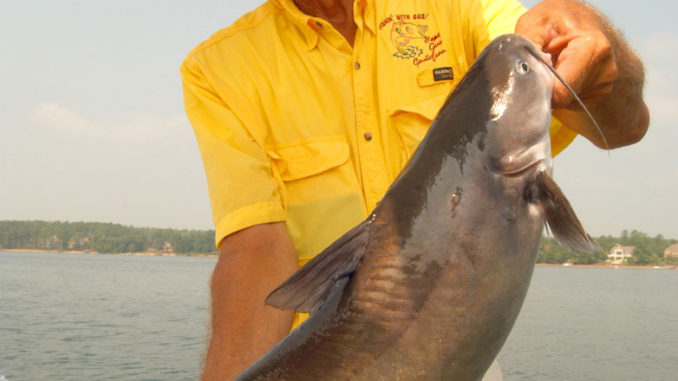
Blues, flatheads and channels all give anglers a fighting chance
Guide Gus Gustafson of Lake Norman Ventures said fishing for blue, flathead and channel cats heats up in July at Lake Norman.
“Norman has good numbers of all three species,” said Gustafson, who turns to the big cats for action when hot weather slows the fishing for largemouth, spotted and hybrid bass.
Gustafson (www.fishingwithgus.com) said most fishermen covet Norman’s big blues.
Early in July, before the temperatures start sizzling, Gustafson said blues can be found either in the backs of coves or along creek channels in 7 to 20 feet of water. Once the weather gets hot, they move to the main channel, where they often suspend in 40 to 60 feet of water.
Fish are caught either by slow-trolling or drifting with Carolina rigs baited with cut shad or strips of perch or bream. The depth determines the size of the weights used with the rigs.
While the majority of summer blues will be in the 20-pound range, fish twice that size are present. For that reason, stout tackle and sturdy hardware is necessary.
“In addition to heavy-action rods and baitcasting reels, anglers need No. 5/0 to 8/0 wide-gap hooks to penetrate the thick jawbone of a big cat,” Gustafson said. “A 60-pound test leader is recommended, because blues twist and turn to break free after they’re hooked. A big net with a heavy duty handle is also essential.”
If the weather gets unbearably hot, fishing for mid-sized blues gets even hotter. The warm temperatures force large numbers of blues to the cooler waters near Cowans Ford Dam. The intense heat might cause a fish kill, usually stripers, and the blues will feed upon the dying fish. Cut bait dropped amidst the carnage will not go unnoticed, according to Gustafson.
“It’s not unusual to catch 10 to 50 blues before the action wanes around 10 a.m.,” he said.
Gustafson said most flatheads are caught in areas where white perch are gorging on forage fish. The flatheads linger below the melee to feed upon scraps. Anglers lowering white perch below the feeding whites often find themselves engaged with flatheads weighing 10 to 50 pounds.
Other anglers use a 21/2-ounce jigging spoon in silver, white or chartreuse with a strip of bait impaled on a single treble prong. They’ll bounce the jig in front of the flatheads while drifting or slow-trolling.
“With no wind, fishermen rock their boats to impart action to their jigs,” said Gustafson.
Channel cats keep the youngsters busy. They’re taken in the backs of coves in 10 to 15 feet of water with worms and prepared baits. Set out a spread of rods around the boat and enjoy the action.




Be the first to comment